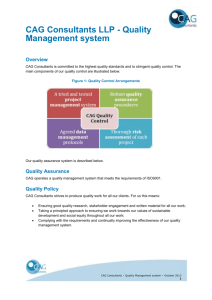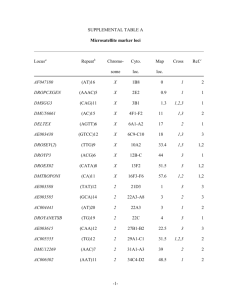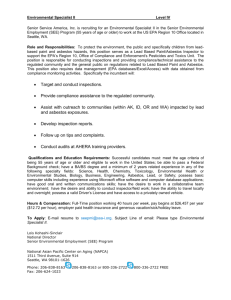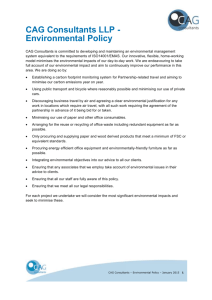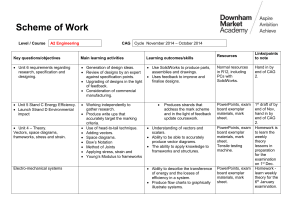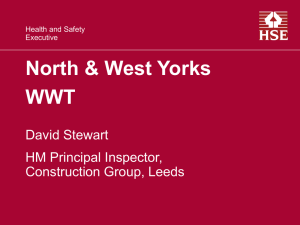Libby Community Advisory Group Meeting Summary March 8, 2007 Introductions
advertisement
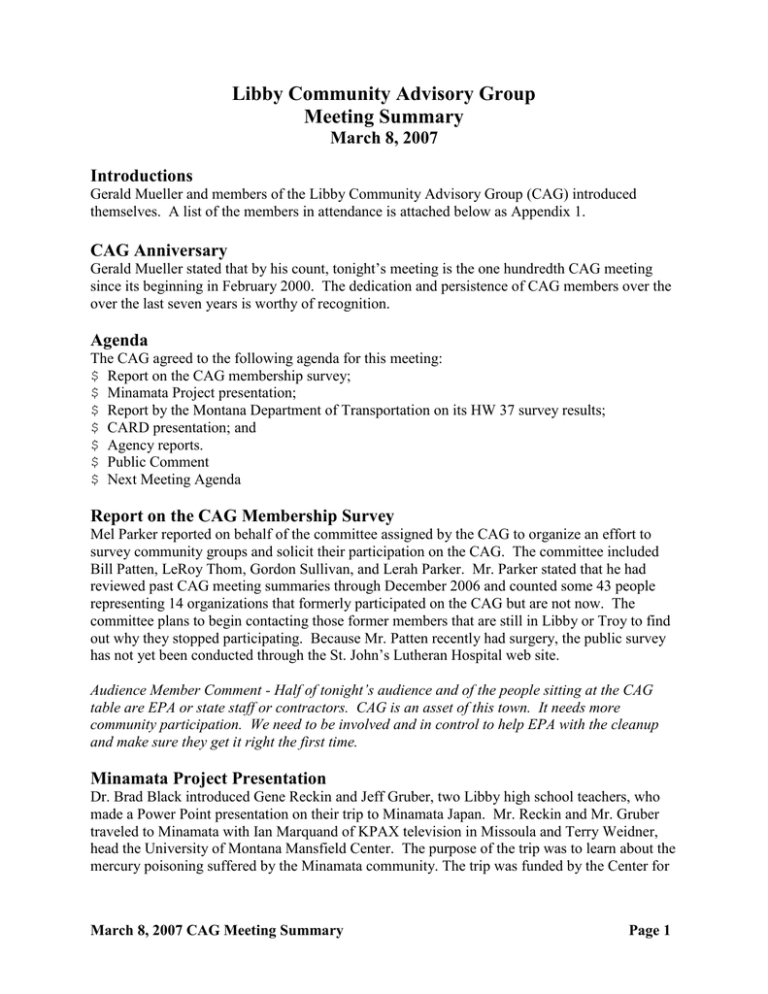
Libby Community Advisory Group Meeting Summary March 8, 2007 Introductions Gerald Mueller and members of the Libby Community Advisory Group (CAG) introduced themselves. A list of the members in attendance is attached below as Appendix 1. CAG Anniversary Gerald Mueller stated that by his count, tonight’s meeting is the one hundredth CAG meeting since its beginning in February 2000. The dedication and persistence of CAG members over the over the last seven years is worthy of recognition. Agenda The CAG agreed to the following agenda for this meeting: $ Report on the CAG membership survey; $ Minamata Project presentation; $ Report by the Montana Department of Transportation on its HW 37 survey results; $ CARD presentation; and $ Agency reports. $ Public Comment $ Next Meeting Agenda Report on the CAG Membership Survey Mel Parker reported on behalf of the committee assigned by the CAG to organize an effort to survey community groups and solicit their participation on the CAG. The committee included Bill Patten, LeRoy Thom, Gordon Sullivan, and Lerah Parker. Mr. Parker stated that he had reviewed past CAG meeting summaries through December 2006 and counted some 43 people representing 14 organizations that formerly participated on the CAG but are not now. The committee plans to begin contacting those former members that are still in Libby or Troy to find out why they stopped participating. Because Mr. Patten recently had surgery, the public survey has not yet been conducted through the St. John’s Lutheran Hospital web site. Audience Member Comment - Half of tonight’s audience and of the people sitting at the CAG table are EPA or state staff or contractors. CAG is an asset of this town. It needs more community participation. We need to be involved and in control to help EPA with the cleanup and make sure they get it right the first time. Minamata Project Presentation Dr. Brad Black introduced Gene Reckin and Jeff Gruber, two Libby high school teachers, who made a Power Point presentation on their trip to Minamata Japan. Mr. Reckin and Mr. Gruber traveled to Minamata with Ian Marquand of KPAX television in Missoula and Terry Weidner, head the University of Montana Mansfield Center. The purpose of the trip was to learn about the mercury poisoning suffered by the Minamata community. The trip was funded by the Center for March 8, 2007 CAG Meeting Summary Page 1 Global Partners, the Greater Montana Foundation, and Libby Public Schools. Mr. Reckin and Mr. Gruber summarized the history of the environmental disaster caused by the methyl mercury contamination of Minamata River and Bay, the source of which was waste water discharged by the Chisso Corporation. Mr. Reckin and Mr. Gruber discussed the nature of the environmental contamination, the disease caused by exposure to methyl mercury from consumption of seafood, the response of the Japanese government and legal system to the disease, the environmental cleanup that occurred in the river and bay, and the community’s March 8, 2007 CAG Meeting Summary Page 2 response to the disaster and cleanup. They closed their presentation by comparing what has happened at Minamata with the situation in Libby caused by asbestos contamination. The similarities and differences they discussed included: Similarities $ Innocent victims - People from both communities experienced disease and death due to the exposure of toxins in their environment caused by one industrial company. In the case of Minamata, 2,265 victims have been “certified,” 11,540 people have received medical care, and total of 13, 805 individuals were affected. An unknown number of victims died before 1956. $ “Company towns” - Employment in both Libby and Minamata were dominated by large industrial companies. In Minamata, the major employer was Chisso Corporation, and in Libby the major employer was W.R. Grace and the lumber mills. $ “World class operations” - Both Chisso and W.R. Grace were major producers in the world market of their respective products, acetaldehyde and vermiculite. $ Emerging knowledge of poison’s toxicity - As has been the case in Libby, both the medical and scientific communities had to learn about the disease and its effects resulting from the toxic exposure. $ Governmental association - In both Libby and Minamata, government environmental regulatory agencies first failed to protect their respective communities and then played a role in cleanup and in providing assistance to victims. $ Environmental cleanup - At both sites government agencies ordered and oversaw cleanup of the contamination. At Minamata, sludge removal in the Minamata River and Bay began in 1977 and was completed in 1990 at a cost of $360,000,000. $ Medical programs for victims - In both communities, the industrial corporation provided medical programs for victims. $ Victim definition unclear - In the case of both environmental exposures, controversy existed about who was qualified to receive medical assistance a “certified” victim. Differences $ No new disease cases - No new cases of Minamata disease have occurred since 1975. In Libby new asbestos-related disease cases are occurring. $ The town of Minamata has moved forward - The environmental cleanup at Minamata has been completed, and Minamata victims, citizens at large, the town government, and Chisso employees have agreed that the rebirth of the city must be centered around the environment. $ Litigation - Some litigation occurred by the victims against the Chisso Corporation. The Japanese courts ordered the national government to create a victim’s compensation program, and the Japan Supreme Court ruled that the national and prefectural governments were negligent and loosened the victim certification requirements. Two Chisso executives were convicted of involuntary manslaughter as a result of the contamination resulting from the waste water discharges. In the US, litigation is more prevalent than in Japan, and much more litigation has occurred regarding asbestos. Considerable litigation has occurred and continues against W.R. Grace. $ Japanese view of the Chisso Corporation v. Libby view of W.R. Grace - Chisso continues to be an integral part of the Minamata community. March 8, 2007 CAG Meeting Summary Page 3 Review Draft - Not for Quotation Mr. Reckin and Mr. Gruber also noted that in 1979, the National Institute for Minamata Disease opened. It has become an internationally recognized leader in heavy metal toxicology research. The Institute is affiliated with the Kumamoto University Department of Clinical Medicine. It provides rehabilitation facilities for patients, facilities for animal experiments, radioisotope experiment facilities, international research collaborating facilities, and a research resource bank. The Institute is supported by the Japanese federal government, the Kumamoto Prefecture, and the Chisso Corporation. They also stated that Minamata has emphasized education about the mercury contamination and has opened a Municipal Museum including a Minamata disease archives and an environmental March 8, 2007 CAG Meeting Summary Page 4 Review Draft - Not for Quotation education center. March 8, 2007 CAG Meeting Summary Page 5 Review Draft - Not for Quotation Audience Member Question - Did the Chisso Corporation apologize to the Minamata community? Answer - Yes. The president of Chisso apologized. There is a famous photograph of him apologizing to a victim and crying while doing so. CAG Member Comment - The action of the Japanese Supreme Court regarding Chisso and the state and federal government has a ring of justice to it. March 8, 2007 CAG Meeting Summary Page 6 Review Draft - Not for Quotation Audience Member Comment - I was struck by the comment you quoted from the Mayor of Minamata that, “Minamata disease was caused because we prioritized economy over human life.” This is a contrast to our OSHA and NIOSH that are required to take economic impact into account in setting standards. Response - Today’s Missoulian carried a story about the mercury content of the hair of state government officials. We are always behind in our knowledge of the effect of toxic exposures. We need to support scientists to understand these issues. For a while we produced products without understanding their toxic side effects. When we understand these effects, we need to act. Audience Member Comment - Through free trade, products that have been banned here because of toxicity are re-entering this country. Audience Member Question - Is there an equivalent agency to our EPA in Japan? Answer - Yes, the Ministry of the Environment. MDT Presentation Brian Goodman, Chief of the Environmental Services Bureau of the Montana Department of Transportation (MDT) introduced Ryan Behrends, an MDT contractor with Tetra Tech. In July, 2006, Tetra Tech conducted sampling using the EPA protocol along Libby area roads for asbestos contamination. Mr. Behrends presented the results of the sampling using a power point presentation. Tetra Tech took 284 soil samples within a five mile radius of Libby on the rights of way (ROWs) of US-2, Montanan Highway-37, and state routes 260, 482, and 567. Soil samples were collected within 10-feet of the pavement boundary at approximately 0.25 mile intervals along both sides of selected ROWs. Mr. Behrends showed pictorial maps of the sample locations. Soil samples were also collected from 10 of the 17 pits or stockpiles of traction sand and road aggregate identified by MDT, from surface soil at the MDT Libby Maintenance Section Facility, and from road sweepings piles from two road sweepers. Soil samples were submitted to the Camp, Dresser, and McKee (CDM) laboratory in Denver, Colorado for preparation in accordance with standard operating procedure (SOP) ISSI-LIBBY-01 before being shipped on to EMSL, Inc. in Westmont, New Jersey for PLM analysis for asbestos, including Libby amphibole asbestos, in accordance with SOP SRC-LIBBY-03 (Revision 1). The analysis determined that all soil samples along the road ROWs, at the maintenance section facility and of the road sweepings were non-detect for asbestos. Asbestos was found in seven samples collected from the gravel pit located along the gravel road to the former W.R. Grace Vermiculite Mine. This pit also contained visible vermiculite. Air samples were also collected during several routine MDT maintenance activities performed along Highway 37, including, guardrail replacement, road sweeping by the broom-style and vacuum style vehicles, ditching, and mowing. Four air sampling pumps and cassettes were placed on each piece of equipment. One air sampling pump was placed on each side. Additional pumps were placed, one on the operator, and one on each laborer (if present) to sample the fugitive dust emitted during the routine activities. The air samples were also submitted to EMSL, Inc. in Westmont, New Jersey for analysis for asbestos, including Libby amphibole asbestos, first using a March 8, 2007 CAG Meeting Summary Page 7 phase contrast microscope (PCM) and then a transmission electron microscope (TEM). MDT workers also wore personal air samplers during normal right-of-way work such as grass mowing. Asbestos was detected in some of the air samples. The highest (PCM) value of 0.075 fibers per cubic centimeter (f/cc) was collected on the front of the mower during mowing. The highest TEM result was for the samples collected on the front of the mower during mowing and was equivalent to the PCM result (0.075 f/cc; tremolite/actinolite) for that sample. Due to the low air sample volumes resulting from the short duration of the activities sampled and the inherent dusty conditions, the limit of laboratory detection for TEM analyses ranged from as low as 0.004 f/cc to 0.026 f/cc. The highest detection limit of 0.026 f/cc. All air concentrations were significantly less than the relevant OSHA standard. March 8, 2007 CAG Meeting Summary Page 8 Review Draft - Not for Quotation CAG Member Question - You said that no asbestos was found in any of the samples along the roads? March 8, 2007 CAG Meeting Summary Page 9 Review Draft - Not for Quotation Answer - Yes. All soil samples came back non-detect for asbestos. We did find asbestos in the air samples. CAG Member Comment - I find this to be odd, because Jim Christiansen told the CAG in 2005 that asbestos was found in all samples along Highway 37 from the Kootenai River Bridge to Rainy Creek Road. CAG Member Question - You also said you found asbestos in one aggregate pit. Why did you sample that pit? Answer - MDT told us that this pit was used as the source of aggregate for the 1996 reconstruction of Highway 37. CAG Member Comment - Quoting from the June 10, 2005 edition of the Western Montana News: March 8, 2007 CAG Meeting Summary Page 10 Review Draft - Not for Quotation A sampling team found visible vermiculite in several locations along the highway, suggesting the material may have spilled from trucks coming from the mine to the expansion plant... Christiansen said there is considerable information available that convinced him the contamination is from spillage and that the vermiculite from the mine was not used as fill or base on the highway or as winter sanding material. March 8, 2007 CAG Meeting Summary P a g e 11 Response by Paul Peronard - The MDT findings are not necessarily inconsistent with Mr. Christiansens’ statements. As we explained at last night’s town meeting, a non-detect PLM reading does not mean that asbestos is not present in the soil, just that the concentration is below detection limit using PLM sampling. Asbestos was found in the air sampling along the Highway 37 right of way. CAG Member Comment - I believe that the source along the roads is spillage from the trucks that EPA is using to haul contaminated material to the mine. CAG Member Question - How could Mr. Christiansen find asbestos in every soil sample along Highway 37, but you did not? Answer - I don’t know. We used the same sampling protocol as EPA uses. We did see visible vermiculite in the pit. Comment by Van Swearington, the local MDT section leader - The air sampling that accompanied the Highway 37 activities over lapped each other during the course of the three weeks of sampling. The sampling was done in a professional manner. Response - The activities were very dusty, and we had difficulty pulling the samples. The asbestos was found not in the soil but in the air. Audience Member Question - Did you coordinate the air sampling with EPA? EPA told us at last night’s town meeting that it is experimenting with reducing the pore size of the air filters. Did you use the smaller pore size? Response by Paul Peronard - Tetra Tech’s air sampling was consistent with EPA protocol. The testing that we spoke of last night does not mean that we have changed the pore size in the filters we use. Audience Member Comment - The fact that the air sampling results were less than OSHA standards does not mean that twenty years of exposure along the roads will not have adverse health effects. The standard is based on chrysotile asbestos, not the Libby amphibole which is more toxic than that chrysotile. Response - These are the standards that are in effect now. We did recommend that the MDT workers wear respiratory protection when working along Highway 37. March 8, 2007 CAG Meeting Summary Page 12 Review Draft - Not for Quotation CAG Member Question - The pit with contamination had a permit to produce 50,000 cubic yards of material. Some was used on Highway 37, some was used in subdivisions, some was proposed for backfill at the export plant site. Will you chase down where the material from this pit was used? March 8, 2007 CAG Meeting Summary Page 13 Review Draft - Not for Quotation Answer by Paul Peronard - After the road to the mine was closed, no more material came out of the pit along Rainy Creek Road. We did pursue records of where material from this pit was used, but did not find them. Rather than trying to chase down where this material was used before the road closure, we are more likely to find contamination by direct sampling of Libby roads, alleys and yards. We do have to decide when to cleanup the roads and alleys, but we are focusing first on where people work and play. We believe that the exposure risk is greater in people’s yards and gardens than the roads and alleys. CAG Member Comment - I built the skating pond and walking path for W.R. Grace with material from the contaminated pit. My requests to show EPA where the material was used have been ignored. Response by Paul Peronard - We will have someone go with you to the sites where you believe contaminated material was used. Audience Member Comment - Thank you to MDT for this information. CARD Presentation Mike Giesey gave the first of a series of presentations that the Center for Asbestos Related Disease (CARD) will be giving to civic groups in town. Mr. Giesey asked for feedback on the presentation from CAG. CARD was first created to assist the Agency for Toxic Substances Disease Registry (ATSDR) with screening in 2000 -2001. Some 18% of those screened had lung abnormalities, compared to the national average of 0.2-2.3%. In 2003, CARD obtained its 501(c)(3) tax-exempt, non-profit status from the Internal Revenue Service. CARD is governed by an eleven member board of directors. CARD staff includes: three doctors, Dr. Brad Black, Dr. Alan Whitehouse, and Dr. Mark Heppe; two nurses, Kimberly Rouse and Deb Cirian; a respiratory therapist, Ashley Day; a licensed clinical social worker, Tanis Hernandez; and four administrative/support staff; Terra Thrasher, Pam Roll, Cheryl Roediger and Cheryl Fox. CARD funding comes from fee for services, medical insurance, the WR Grace Medical Plan, the Libby Asbestos Medical Plan (LAMP), research grants, and private donations. March 8, 2007 CAG Meeting Summary Page 14 The role of CARD is to provide caring pathways to treatment of asbestos related disease. Its primary focus is health care outreach and research. It provides screening services including pulmonary function testing for the population exposed to Libby amphibole asbestos. It advises patients about seeking medical treatment and tracks patients. In 2003, CARD convened a conference to determine whether it could and should act to facilitate asbestos disease-related research. The participants advised that because of the unique experience with asbestos exposure in Libby, the large population exposed through the environment and/or occupationally over a long period of time, CARD should carry out this facilitation role. Several of the conference participants are now members of a CARD committee of research advisors. CARD facilitates research by providing asbestos researchers with medical records and blood and tissue samples. The CARD board oversees these facilitation activities to ensure a focus on Libby related health care and that Libby people are not exhausted by the research process. The CARD goal for the research is to increase knowledge with as little disruption as possible for disease patients about asbestos disease therapy and how to interfere with disease progression and to increase the quality of life for disease patients. How can you assist CARD? You can spread the word about it to friends and neighbors, and you can donate blood. Blood is drawn every other Thursday. You can arrange a 15 minute appointment to do so. Because the sensitivity of individuals to asbestos disease varies, blood is needed both from people who are sick and those who are not, and from people who have been exposed to Libby amphibole asbestos and those who have not. On February 20, the CARD made first of a series of three presentations held at 7:00 p.m. in this room. Its topic was what a Libby research center is all about. The second is scheduled for March 20, and its topic is how we create a successful research center. The third, on April 17, will address what research projects are happening. Audience Member Question - Is the research on blood markers for asbestos related disease producing encouraging results? Answer by Dr. Black - Yes. Research is underway in Australia and New York City on proteins found in the blood that may serve as early indicators for mesothelioma. In Australia, the protein marker test is used as a clinical tool. We need more research on the normal range of proteins in people not exposed to asbestos and in people with the disease. EPA Report Mike Cirian reported on behalf of EPA. Because of the lateness of the hour, the report was brief. Cleanup will begin again on April 2. The task order for the cleanup construction activity is about to be awarded. Funding for the toxicology studies has been approved. Personnel from both the Volpe Center and CDM will be here this summer. Please come and see Mr. Cirian if you have cleanup related questions. State Report Catherine LeCours reported on behalf of the state. She will be moving into offices near the Troy City Hall the first week of April. The pre-clean up investigation will begin in May. March 8, 2007 CAG Meeting Summary Page 15 Public Comment CAG Member Comment - I have good news about the Libby medical funding bill. HB 407, sponsored by Rep. Chas Vincent, passed the House Appropriation Committee last week in an amended version on a 10-9 vote. The amendments reduced the funding from $3 million to $2 million, $1 million per year. The second year’s $1 million is contingent on a showing of how the first year’s funding was spent. The money will be provided via a grant from the Montana Department of Health and Human Services to the Lincoln County Health Board. The bill passed the House on second reading today on a 91 - 9 vote. CAG Member Comment - According to the April 10, 2003 meeting summary, a CAG member asked about the status of the mine cleanup. The answer given by Jim Christiansen was, “Because of its isolation, the mine site is a lesser cleanup priority. About $1 million has been allocated in the 2004 budget to begin the investigation of the mine and mine road, including air quality sampling and sampling on USFS and Plum Creek lands.” Whatever happened to this $1million? Answer by Paul Peronard - I don’t know, but I will check and report back to you. Next Meeting Agenda Topics The CAG agreed to the following topics for its next meeting: $ Report on the CAG membership survey; $ Karmanos Cancer Center presentation; and $ Agency reports. Next Meeting The next meeting is scheduled for 7:00 to 9:00 p.m. on April 12, 2007 in the Ponderosa Room of Libby City Hall. Appendix 1 CAG Member & Guest Attendance List March 8, 2007 Members Mike Giesey DC Orr Rita Windom Ken Hays Ted Linnert Mike Cirian Paul Peronard Catherine LeCours Dr. Brad Black Eileen Carney Group/Organization Represented CARD City of Libby Lincoln County Commission Senior Citizens EPA EPA EPA Montana Department of Environmental Quality Lincoln County Health Officer Board of Respiratory Therapists March 8, 2007 CAG Meeting Summary Page 16
